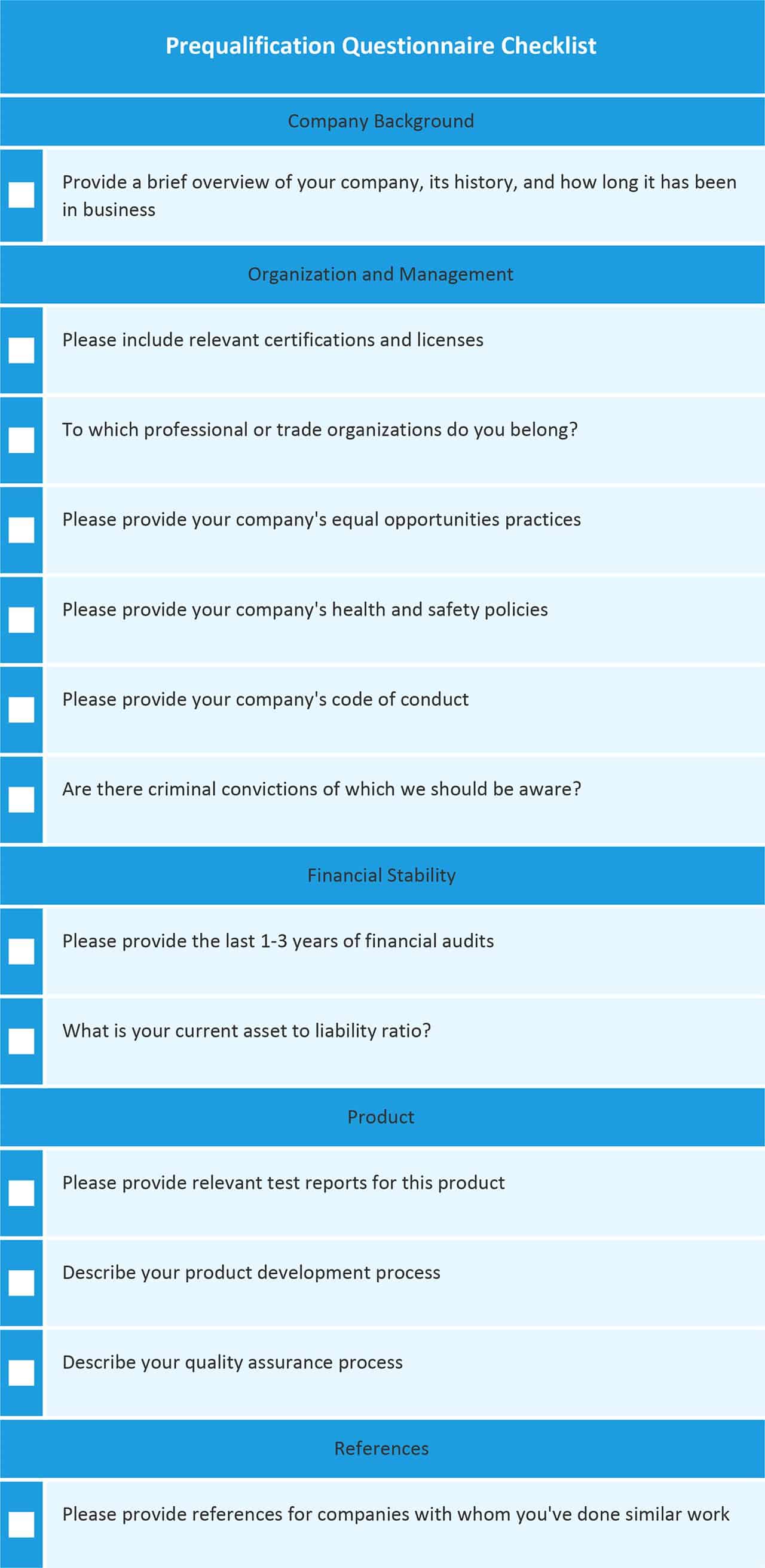What Is a Request for Quotation (RFQ)?
A request for quote (RFQ) is a business practice for procuring products or services. Companies use RFQs to invite vendors or suppliers to submit price quotes. This process allows organizations to compare offers and select the vendor or supplier providing the best value.
RFQ vs. RFP vs. RFI
An RFQ is crucial for making cost-effective business decisions. Companies use requests for proposals (RFP) and requests for information (RFI) during the procurement process. Though these terms can be confusing, each serves a distinct purpose. Here are the main differences:
- Use an RFI to learn how an organization meets your specific project requirements. You’re looking for information. Learn how to write and respond to construction RFIs. Use RFI templates to gather information from vendors and suppliers.
- Use an RFP if you have a roadmap for your business solution, but want someone to help you finalize the plans and contribute to the creative process. You’re looking for proposals.
- Use an RFQ when you know exactly what to buy and are looking for the best price. You’re looking for price quotes.
This graphic portrays the process of moving from an RFI to an RFP and RFQ:
RFQ Process
The RFQ process involves the potential vendors of the goods or services you want to purchase, what you expect from their bids, the timeline for evaluating the responses, and the criteria for choosing a supplier.
You can use software to automate some of this process. SaaS (software as a service) companies or e-sourcing systems can do the following: host online platforms that include questions for vendors; secure online hosting where vendors can submit responses and upload overall company profiles; track and score submissions; and notify suppliers.
Whether you invest in software or manage RFQs internally, the process remains the same.
Here's a graphic that depicts the process:
- Prepare to Request Quotes
The RFQ preparation phase is vital to streamlining the bidding process and running it efficiently. Start by collaborating with managers and internal stakeholders to define the project’s purpose, scope, requirements, and integral products or services, including quantities. Establish a budget to guide bidders on cost limitations and ensure accurate pricing. Designate a point of contact to address questions. Determine the bid type. Here are the bid types and how they work:
- Open Bid: The RFQ is open to all potential vendors. All bids on the project are visible to all competing suppliers. While such transparency can help drive down pricing, it can also lead to price fixing or collusion among vendors.
- Sealed Bid: The buyer opens all the bids at the same time, after the submission deadline has passed. Vendors don’t know the quotes submitted by other suppliers until the company opens the bids. Sealing bids can help you fight fraud during the bidding process and add a layer of transparency. This option is especially beneficial if you are managing a public or government project.
- Invited: You invite specific vendors, usually those you’ve already worked with, to bid on the project. You can use this process with either open or sealed bids.
- Reverse Auction: In a typical auction, the seller is hoping to get the highest price for a project. RFQs are a form of reverse auction. If you do not get the price you want during the first round of an RFQ, you can ask selected vendors to offer the lowest price for the project you want to outsource.
- Identify Vendors
Research vendors by searching online, utilizing industry-specific directories and databases, seeking recommendations from colleagues or other companies, leveraging existing vendors, or posting an open bid. After researching, decide which vendors are suitable for your project. Ensure that the selected vendors have the qualifications and experience to meet your project goals.
- Complete the RFQ Document
Complete your RFQ by using a template to save time and ensure that the information is organized and comprehensive. The RFQ should clearly outline the products or services you need, commercial requirements, budget, submission criteria, and terms and conditions.
Your RFQ should include the following:
- Buyer’s contact information
- Vendor’s contact information
- Submission requirements and deadline
- RFQ reason and project scope
- List of products or services
- Product quantities and requirements
- Delivery requirements
- Selection criteria
- Terms and conditions
- Designs or schematic drawings
Find RFQ templates in all formats for construction, freight, IT, government, and nonprofit projects.
- Distribute the RFQ Document
Send the RFQ and supporting documents to your selected vendors. Include the submission deadline, allowing enough time for them to respond with a thoughtful quote. Include a point of contact, so the recipient knows whom to contact with questions. You can send RFQs by email or mail depending on your project’s level of urgency and your tracking preference.
During this tender phase, when bidders are preparing their bids, it's essential to treat all suppliers equally. Doing so ensures that the bidding process is transparent and fair. Provide the same information to all vendors and abide by any confidentiality requirements you’ve outlined in the RFQ.
- Manage Responses
Track the responses as they come in and acknowledge their receipt. Notify the bid evaluation committee of your progress, so members know how much time to set aside to review the bids. Depending on your process (and the size of the contract), you may choose to open all bids once the deadline has passed or open them as they arrive. If you open the bids as they come in, put safeguards in place to ensure that you’re protecting the confidentiality of each vendor’s response.
- Award the Bid
The awarding phase starts once the submission deadline has passed. The reviewer or review committee compares the submissions based on the selection criteria. If you used a template or form to collect price quotes, it should be easy to compare the bids. The lowest price with the best terms is generally the winner. Create a contract or purchase order to finalize the deal.
Document the winner, the process, the number of bids, and the criteria in an internal memo. This information is valuable to the internal auditor and will guide future projects.
- Close the Bid
During the closing phase, finalize and sign the contract. Doing this should be easy because you have already documented many of the contract details during the RFQ process, including terms and conditions, payment details, and other deliverables. Complete any minor negotiations that may remain, such as packaging, changes in pricing levels, or the delivery schedule.
Once both parties have signed the contract, notify the other bidders that you’ve chosen a winner and thank them for their participation. You may want these other vendors to be part of your product cycle in the future. Treat them ethically at this stage, so they’re willing to invest the time in bidding on future projects.
Use a flowchart template to organize and visualize your RFQ process.
Documents Used in the RFQ Process
A request for quote template helps organizations procure the most cost-effective products or services they need for a project. An RFQ template also helps you find a vendor that best suits your needs. Check out these related RFQ templates to streamline your procurement process.
RFP Template
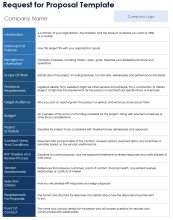
Use an RFP template to outline project details and solicit vendor proposals, enabling you to select the best solution for your project needs.
RFI Template
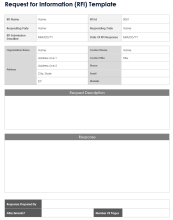
Use an RFI template to collect product or service details from suppliers, and create a list of suppliers that can meet your project requirements.
SOW Template
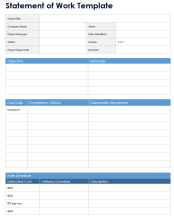
Use a statement of work (SOW) template to outline the work and serve as a negotiable contract with a vendor or supplier.
Invitation to Bid Template

Use an invitation to bid template , also known as an invitation to tender template, to invite contractors to bid on a construction project and generate competing offers.
RFQ Process Pack
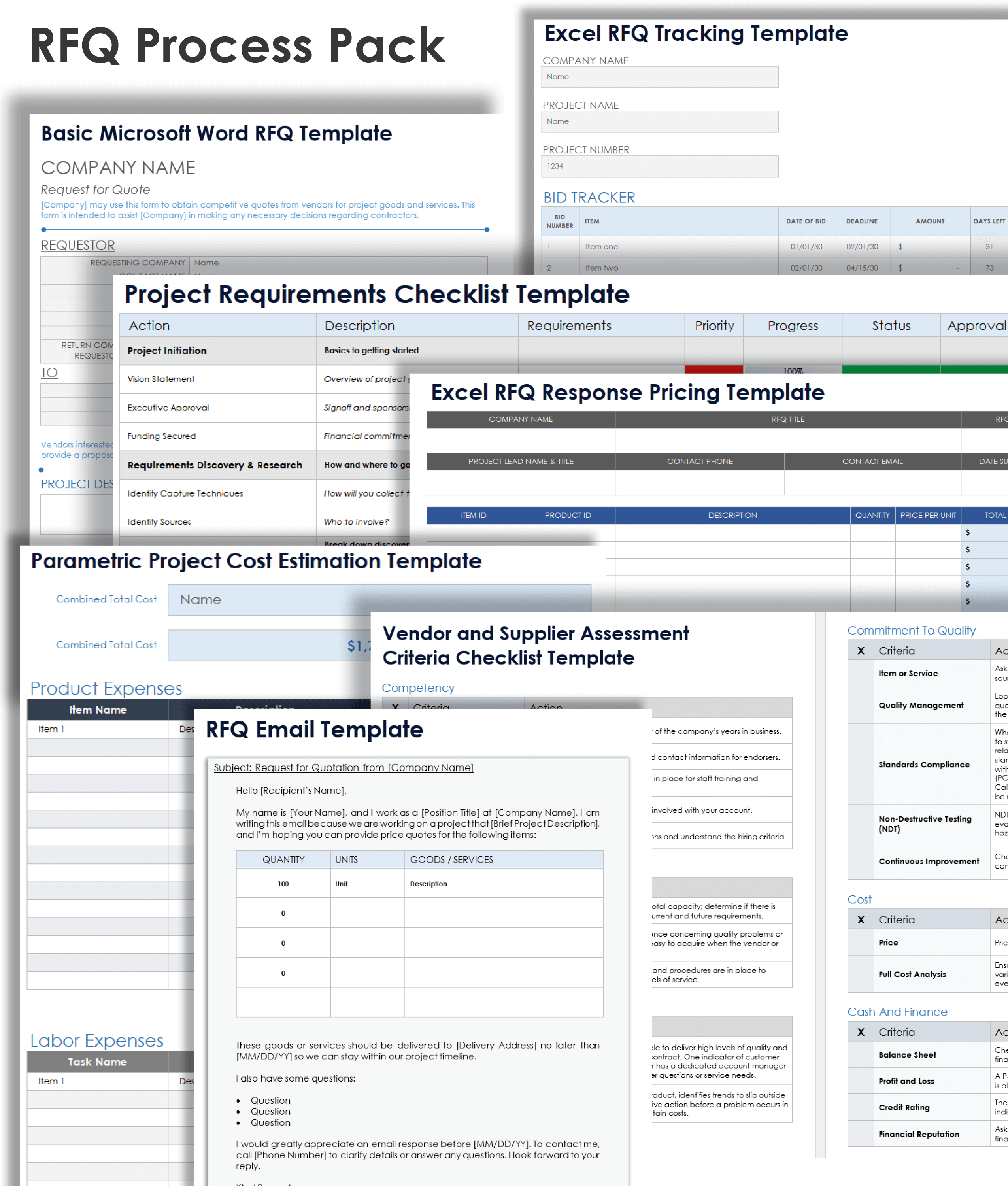
Use this RFQ process pack to help you plan, solicit, and manage the price quotes for your project. This pack includes customizable templates for budgeting, assessing potential vendors, providing vendors with project specifications, tracking bids, and more. Download the pack as a whole or each template individually based on your needs.
Included in this pack, you’ll find the following templates:
- A project requirements checklist template for Excel to account for every project requirement.
- A parametric project cost estimation template for Excel to calculate the cost per unit of your project’s goods, services, and labor.
- A vendor and supplier assessment criteria checklist template for Microsoft Word to evaluate and rate prospective and current partners.
- An RFQ template for Microsoft Word to provide vendors with project details and a list of required services and products.
- An RFQ response pricing template for Excel that vendors complete and submit in response to the RFQ.
- An RFQ email request template for Microsoft Word to connect and share your project requirements with vendors, allowing them to assess whether they can fulfill your needs.
- An RFQ tracking template for Excel to organize the items for bid, the bidding invitation dates, and the deadlines.
How to Write an RFQ
Providing the requesting company’s information is the first step of any RFQ. Cover key details about the product or service you want to buy. While RFQs vary slightly by industry, they generally include the same elements. Follow these steps to write an RFQ:
- Enter Requester Information
Provide the requesting company’s name, contact person, email address, and phone number, so the vendor knows whom to contact. By supplying these details, you establish a clear line of communication for the vendor to ask follow-up questions or get clarifications.
- Enter Vendor Information
Include the vendor’s name, email address, and phone number to personalize the RFQ and ensure that the vendor receives it without delay.
- Enter Submission Details
Specify the submission deadline to outline the time frame for receiving quotes and keep the project on schedule. Clearly state the exact date and time of the deadline. If you’re using a standardized response template, include it with the RFQ in order to streamline the bid-reviewing process.
- Enter Project Details
Describe the project’s background and its purpose in order to provide the vendor with the context they need to deliver an informed quote. Outline the objectives, timeline, and budget. Giving vendors this information helps them assess their ability to meet your requirements within the given constraints.
- Enter Services or Products
List the specific services or products you require, including quantities, specifications, and requirements. Doing this allows vendors to determine if they can fulfill the project’s needs and gives them the tools to provide a precise and relevant quote.
- Enter Terms and Conditions
Specify the terms and conditions, such as payment terms, contract duration, warranties, performance penalties or incentives, and renewal options. Stating these terms upfront helps vendors understand the contractual obligations and expectations.
- Attach Supporting Documents
Include relevant documents, such as a prequalification questionnaire to evaluate vendors or a pricing template to easily compare bids. These documents help ensure that all vendors have the same information, facilitating a fair and efficient evaluation process.
How to Write an RFQ Email
Sending an email is a simple and convenient way to contact vendors for price quotes. Always use a professional and friendly tone, clearly explaining the email's purpose and listing the goods or services you need. Follow these steps to craft an effective RFQ email:
- Write a Subject Line
Write a clear and concise subject line that communicates the email’s intention. Include “Request for a Quote” and the company’s name in the subject line. Doing this alerts the recipient to your identity and the purpose of your email.
- Include a Greeting
Begin your email with a greeting such as “Good afternoon,” followed by the recipient’s name. Doing this makes the email more personable. Introduce yourself and explain your position in the organization. A greeting is a friendly and polite way to start the communication. Explain that you are requesting price quotes for specific goods or services. Then communicate the project’s purpose.
- Write the Body
The body of the email should contain a list of the products or services and the quantities. By formatting the products or services with numbers or bullets, you provide a more readable structure. Specify the delivery address and ask about delivery fees. Additionally, inquire about the expected delivery times to ensure that they align with the project timeline.
- Close the Email
Include the date by which you require a response. Inform the recipient that you look forward to their reply and that they can contact you with any questions. End with your name and contact details.
RFQ Best Practices for Writing an Effective RFQ
You’re more likely to receive better bids when you follow a well-organized RFQ process. Start by determining project details such as goals, needs, and budget. Engaging in such preparation allows you to effectively communicate the purpose of the request to bidders. Follow these best practices to write an effective RFQ:
- Be Specific: Tell vendors the exact requirements for your project’s goods or services, and ask them to be precise in their response.
Ian Jennings is a qualified financial advisor and the Founder of Harbour View Mortgages: “For our RFQ on a financial forecasting tool, I included detailed specifications about the algorithms required, integration capabilities with our current software, and necessary data security measures.” He adds, “Providing such specificity ensured that we received tailored and relevant proposals.” - Define Your Expectations: Describe what you want in the RFQ response. Your business depends on whether the vendor can deliver. Describe what you want, when you want it, and what happens if the vendor exceeds your expectations about deliverables — or fails to deliver.
- Ask Relevant Questions: Time is a precious resource for companies. Ask questions that specifically relate to your product. Jennings says, “To avoid misunderstandings, I always include a Q&A period in our RFQ process. During a procurement for a new loan origination system, this step helped clarify doubts and led to more accurate and suitable proposals.”
- Set Appropriate Deadlines: Give vendors an adequate time frame to prepare a thoughtful response. For smaller RFQs, two weeks is a good start. Add more time depending on the size of the project and the amount of information in the RFQ. Jennings notes, “I provide timelines that consider the complexity of our needs and the time vendors need to create comprehensive responses. When you give ample time, you receive well-thought-out proposals rather than rushed and incomplete ones.”
- Review and Revise the RFQ: Once you draft the RFQ, ask key stakeholders and trusted partners to review it and answer these two questions: Have you correctly identified your needs, and have you left out any critical details?
- Send the RFQ to Multiple Vendors: Find the best price and discover new options by sending the RFQ to multiple vendors. However, avoid overwhelming the process by contacting too many vendors; aim for a manageable number. Note that government agencies may have specific requirements for the number of vendors to approach.
- Build Long-Term Relationships: Having strong relationships with vendors and suppliers helps with RFQ response times and pricing. They are more likely to prioritize your RFQ and offer discounts or more competitive pricing.
Secure the Best and Most Cost-Efficient Vendors for Your Projects by Writing the Perfect RFQ with Smartsheet
From simple task management and project planning to complex resource and portfolio management, Smartsheet helps you improve collaboration and increase work velocity -- empowering you to get more done. The Smartsheet platform makes it easy to plan, capture, manage, and report on work from anywhere, helping your team be more effective and get more done. Report on key metrics and get real-time visibility into work as it happens with roll-up reports, dashboards, and automated workflows built to keep your team connected and informed. When teams have clarity into the work getting done, there’s no telling how much more they can accomplish in the same amount of time. Try Smartsheet for free, today.


